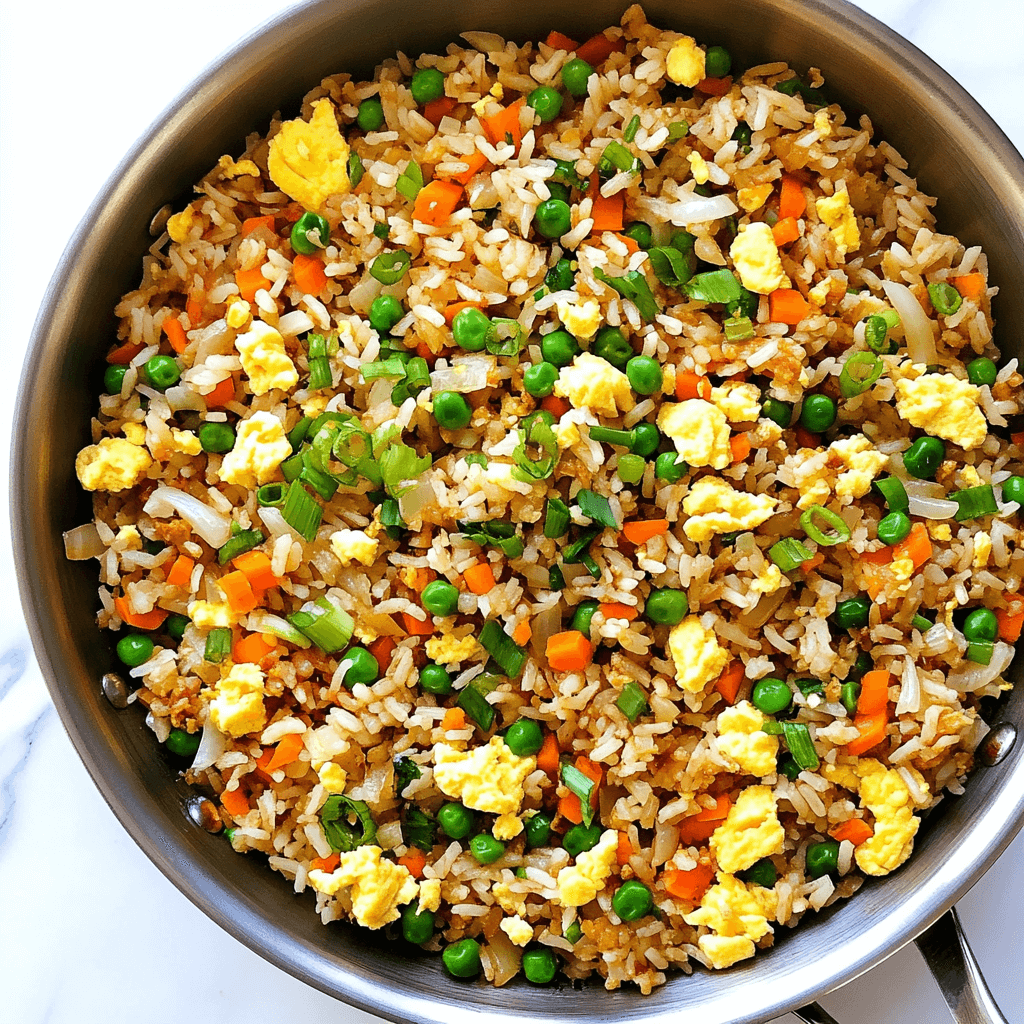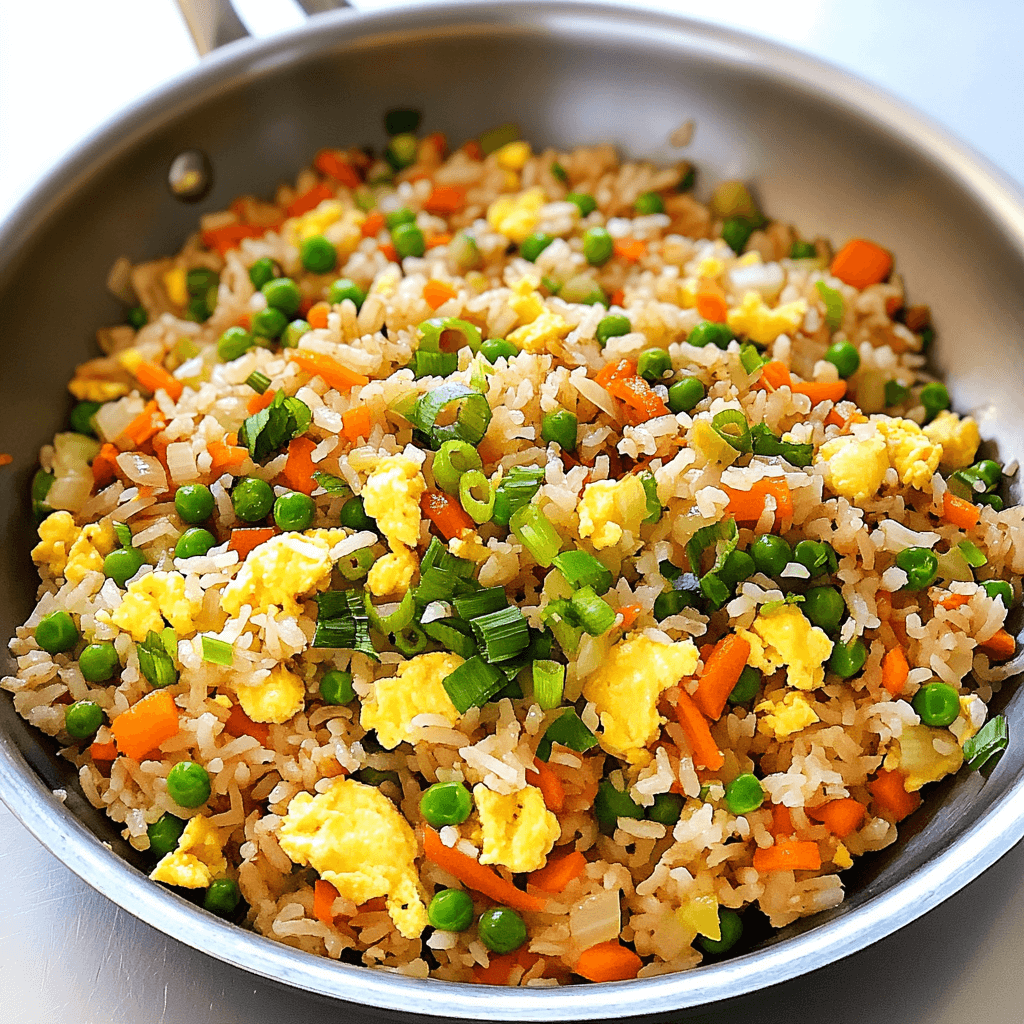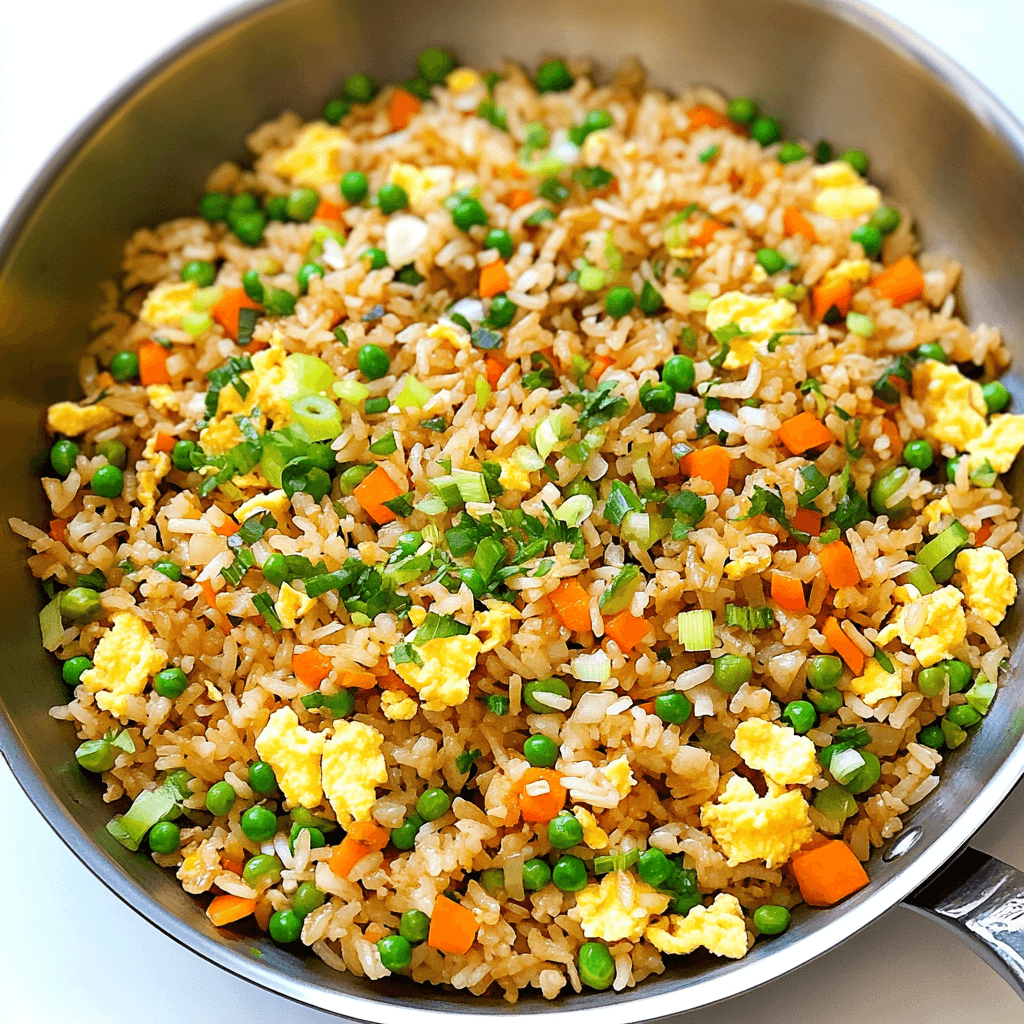Introduction: Why This Fried Rice Recipe is a Must-Try
Fried rice is one of the most popular rice dishes in the world, enjoyed across various cultures for its delicious flavors, quick preparation, and versatility. Whether it’s a classic Chinese fried rice recipe, Thai-style pineapple fried rice, or spicy Indonesian nasi goreng, every region has its own unique take.
The History and Popularity of Fried Rice
Fried rice has its origins in China’s Sui Dynasty (589–618 AD), where leftover rice was stir-fried with vegetables, eggs, and meats to avoid waste. Over time, different cultures developed their own variations, such as:
Japanese Yakimeshi – A simpler version with soy sauce and scallions.
Thai Khao Pad – Features jasmine rice, fish sauce, and Thai chilies.
Indonesian Nasi Goreng – A bolder dish with sweet soy sauce and shrimp paste.
How Homemade Fried Rice Compares to Takeout
Healthier: Control oil, sodium, and fresh ingredients.
More customizable: Add your favorite proteins and vegetables.
Budget-friendly: Uses leftover rice and pantry staples.
Pro Tip: Cooking a fried rice recipe at home gives you control over flavors while ensuring high-quality, fresh ingredients.
Essential Ingredients for the Perfect Fried Rice Recipe
A good fried rice recipe starts with a balance of rice, seasonings, vegetables, and proteins.

The Best Rice to Use for Fried Rice
The type of rice used determines the texture and consistency of the dish.
Jasmine Rice: Light, fragrant, and slightly sticky—ideal for Thai fried rice.
Long-Grain White Rice: Fluffy and firm, great for classic Chinese fried rice.
Basmati Rice: Adds a nutty flavor and stays separate when cooked.
Brown Rice: A healthier alternative with more fiber and a slightly chewy texture.
Pro Tip: Day-old rice is best because it’s drier and prevents sogginess.
Key Seasonings for the Best Fried Rice Recipe
Soy Sauce: The essential base flavor for umami richness.
Oyster Sauce: Adds a subtle sweetness and depth.
Sesame Oil: A finishing touch for aroma and nuttiness.
Fish Sauce: Used in Thai-style fried rice for a unique salty depth.
White Pepper: Provides a mild heat different from black pepper.
Pro Tip: Always add soy sauce sparingly—it’s easier to add more than to fix an over-salted dish.
Essential Mix-Ins: Vegetables, Eggs, and Proteins
Vegetables: Carrots, peas, bell peppers, onions, garlic, and scallions.
Eggs: Scrambled into the rice for richness.
Proteins: Chicken, shrimp, beef, tofu, or even leftovers.
Pro Tip: Pre-cook proteins separately, then add them at the end to prevent overcooking.
The Secret to the Best Fried Rice Recipe: Choosing the Right Rice
The biggest mistake many home cooks make is using freshly cooked rice, which can result in mushy, clumpy fried rice.

Why Cold, Day-Old Rice Works Best
Less moisture: Ensures rice grains stay separate.
Better texture: Prevents a sticky, gluey consistency.
More absorbent: Soaks up seasonings without turning soggy.
Pro Tip: If you don’t have day-old rice, spread freshly cooked rice on a baking sheet and chill it in the fridge for 1-2 hours.
For more Asian cuisine inspiration, check out this gluten-free couscous recipe.
How to Quickly Chill Freshly Cooked Rice
If you need to use fresh rice for your fried rice recipe, follow these steps:
Cook the rice with less water than usual to keep it firm.
Spread the rice on a tray in a thin layer.
Place it in the fridge uncovered for 1-2 hours.
Pro Tip: Avoid using sticky or short-grain rice, as it clumps together easily.
Common Mistakes That Lead to Soggy Fried Rice
Using freshly cooked rice without cooling it first.
Adding too much soy sauce at once.
Overcrowding the pan—causing rice to steam instead of fry.
For more Asian-inspired dishes, check out this pepper steak recipe.
Preparing Your Ingredients Before Cooking
The key to quick and perfect fried rice is preparation. Since stir-frying happens fast, having everything ready before cooking is essential.
The Importance of Mise en Place (Prepping Before Cooking)
Chop vegetables evenly for uniform cooking.
Measure all seasonings beforehand to avoid burning.
Have proteins cooked and ready to mix in.
Pro Tip: Heat your wok before adding oil—this prevents sticking.
How to Chop and Prepare Vegetables for Even Cooking
Dice hard vegetables (carrots, bell peppers) small to cook faster.
Use frozen peas—no need to thaw!
Chop green onions and garlic finely for better distribution.
Pro Tip: Stir-fry harder vegetables first, then add softer ones later.
Prepping Proteins: Chicken, Shrimp, Tofu, or Pork
Chicken: Marinate with soy sauce and cornstarch for tenderness.
Shrimp: Cook separately for 1-2 minutes before mixing in.
Tofu: Press firm tofu and pan-fry before adding.
Pork: Slice thinly and sear before adding to the rice.
Pro Tip: Always cook proteins separately first to maintain texture and avoid overcooking.
For more Asian cuisine inspiration, check out this gluten-free couscous recipe.
Step-by-Step Guide: How to Make This Fried Rice Recipe
Now that you have everything prepped, it’s time to cook! The secret to a great fried rice recipe is stir-frying each ingredient in stages, ensuring that every element is cooked properly while keeping the rice fluffy and flavorful.

Cooking Eggs First for the Perfect Texture
Eggs are an essential part of a fried rice recipe, adding richness and a silky texture. Cooking them first prevents them from becoming overcooked or lost in the rice.
Beat the eggs with a pinch of salt before cooking.
Heat a wok or large pan over medium-high heat and add a bit of oil.
Scramble the eggs lightly, then remove them from the pan and set aside.
Pro Tip: Do not overcook the eggs—they should be soft and slightly runny as they will cook further when mixed with the rice.
Sautéing Vegetables for Maximum Flavor
Heat oil in the pan and add aromatics like garlic, ginger, and onions.
Stir-fry harder vegetables first (carrots, bell peppers), followed by softer ones like peas.
Cook for 2-3 minutes, stirring occasionally to release flavors.
Pro Tip: Use high heat to keep the veggies crisp while infusing them with flavor.
Stir-Frying the Rice to Achieve That Crispy Texture
Add the chilled, day-old rice to the pan, breaking up any clumps.
Drizzle in soy sauce, oyster sauce, and sesame oil, stirring well.
Let the rice sit for 30 seconds before stirring again—this allows a slight crisping effect.
Pro Tip: Avoid over-stirring. Let the rice sit undisturbed in the pan for a few seconds at a time to create those golden-brown crispy bits.
For more Asian-inspired recipes, check out this pepper steak recipe.
Mastering the Stir-Fry Technique for Fried Rice
A perfect fried rice recipe depends on high heat, the right oils, and proper cooking techniques.
Why High Heat is Essential for Great Fried Rice
Prevents mushy rice by evaporating excess moisture.
Creates a smoky “wok hei” flavor, essential for authentic fried rice.
Ensures even cooking of all ingredients.
Pro Tip: If using a home stove, cook in batches to maintain high heat without overcrowding the pan.
The Best Oils for Frying Rice (Butter vs. Vegetable Oil)
Vegetable Oil: A neutral option that doesn’t overpower the flavors.
Sesame Oil: Adds an authentic nutty aroma but should be used sparingly.
Butter: A secret ingredient in Japanese-style hibachi fried rice.
Pro Tip: Use a mix of oils—vegetable oil for frying and sesame oil at the end for flavor.
The Importance of Letting the Rice Brown Without Over-Stirring
Let the rice sit in the pan for a few seconds before stirring.
Avoid adding too much liquid at once to prevent steaming.
Use a spatula to press and toss the rice evenly.
Pro Tip: A cast-iron skillet can work as an alternative to a wok for high-heat stir-frying.
For more rice-based dishes, check out this gluten-free couscous recipe.
Customizing Your Fried Rice Recipe: Variations and Add-Ins
Once you’ve mastered the basic fried rice recipe, you can get creative with different proteins and add-ins.
Chicken Fried Rice: Using Leftover or Freshly Cooked Chicken
Shred or dice pre-cooked chicken for a fast and easy protein boost.
If using raw chicken, stir-fry it separately with soy sauce before adding to the rice.
Use boneless, skinless thighs for extra flavor and tenderness.
Pro Tip: A pinch of five-spice powder enhances the taste of chicken fried rice.
Shrimp Fried Rice: How to Cook Shrimp Perfectly
Use fresh or frozen shrimp, cleaned and deveined.
Cook shrimp separately first, then add at the end to prevent overcooking.
Season with a splash of fish sauce for extra depth.
Pro Tip: Cook shrimp until pink and opaque, about 2-3 minutes per side.
Vegetable Fried Rice: Best Veggies to Use for Extra Flavor
Classic veggies: Carrots, peas, corn, scallions, bell peppers.
Crunchy options: Water chestnuts, bean sprouts, bamboo shoots.
Leafy greens: Spinach or bok choy (added at the end).
Pro Tip: For extra umami flavor, stir in a teaspoon of miso paste or hoisin sauce.
For more vegetable-rich dishes, check out this baby bella mushrooms guide.
Popular Regional Variations of Fried Rice Recipes
Fried rice is a global dish, with each country adding unique flavors and ingredients.
Chinese-Style Fried Rice: Classic Soy Sauce Base
Uses day-old jasmine rice for a fluffy texture.
Includes soy sauce, oyster sauce, and sesame oil for a deep umami flavor.
Common add-ins: Eggs, green onions, and diced pork or shrimp.
Pro Tip: Light soy sauce keeps the rice from becoming too dark or salty.
Thai Pineapple Fried Rice: Sweet, Savory, and Spicy
Uses jasmine rice for a slightly floral aroma.
Includes pineapple chunks, curry powder, and cashews for crunch.
Common proteins: Shrimp, chicken, or tofu.
Pro Tip: A drizzle of fish sauce enhances the authentic Thai flavor.
Japanese Hibachi Fried Rice: Made with Butter and Garlic
Cooked on a flat-top griddle for extra crispiness.
Uses butter, garlic, and soy sauce for rich flavor.
Often served with teriyaki chicken, steak, or shrimp.
Pro Tip: A splash of mirin or sake adds a subtle sweetness.
For more Asian-style dishes, check out this spicy orange chicken recipe.
Troubleshooting Common Fried Rice Mistakes
Even with the right ingredients and techniques, mistakes can happen. Here’s how to fix common fried rice recipe problems so you get perfectly fluffy, flavorful fried rice every time.
Why Your Fried Rice is Too Sticky or Soggy
Issue: The rice clumps together or feels mushy.
Cause: Using freshly cooked rice that hasn’t been cooled properly.
Fix: Always use day-old rice stored in the fridge. If you need to use fresh rice, spread it on a baking sheet and cool it for at least 30 minutes before frying.
Pro Tip: If your fried rice recipe turns out too wet, spread the rice in the pan and let it crisp up without stirring for a few minutes before continuing to cook.
How to Fix Fried Rice That Lacks Flavor
Issue: The rice tastes bland, even after adding soy sauce.
Cause: Not enough seasoning or the sauces were added too early and burned off.
Fix: Add soy sauce and seasonings gradually while taste-testing. Finish with a splash of sesame oil for depth.
Pro Tip: For a flavor-packed fried rice recipe, try combining light and dark soy sauce for a balanced umami taste.
For more seasoning tips, check out this pepper steak recipe.
Preventing Rice from Sticking to the Pan
Issue: Rice sticks to the pan, making it hard to stir-fry.
Cause: The pan wasn’t hot enough, or you didn’t use enough oil.
Fix: Preheat your pan for a minute before adding oil. Add rice only when the oil is hot and shimmering.
Pro Tip: Use a non-stick pan or a well-seasoned wok to prevent sticking and achieve that perfect fried rice recipe texture.
The Best Sauces and Toppings for Fried Rice
A great fried rice recipe isn’t just about the rice—it’s about choosing the right sauces and garnishes to enhance the flavor.
Classic Soy Sauce Blend for Umami Richness
Light soy sauce: Adds saltiness without darkening the rice.
Dark soy sauce: Gives a richer color and deeper flavor.
Oyster sauce: Provides a subtle sweetness and complexity.
Pro Tip: Mix light soy sauce and oyster sauce for a balanced, savory fried rice recipe.
How to Use Oyster Sauce and Fish Sauce for Depth
Oyster sauce: Adds a slightly sweet, umami flavor perfect for Chinese-style fried rice.
Fish sauce: Used in Thai-style fried rice, adding a rich depth of flavor.
Hoisin sauce: A great option for a slightly sweet, smoky taste.
Pro Tip: Use a small drizzle of fish sauce for an authentic Thai fried rice recipe—a little goes a long way!
For more Asian-style sauces, check out this spicy orange chicken recipe.
Garnishes: Green Onions, Sesame Seeds, and Chili Flakes
Green onions: Add a fresh, mild onion flavor.
Sesame seeds: Provide a nutty crunch.
Chili flakes or sriracha: Bring some heat!
Pro Tip: Always finish your fried rice recipe with fresh green onions and a drizzle of sesame oil for the best flavor.
Storing and Reheating Fried Rice for the Best Leftovers
A fried rice recipe makes excellent leftovers, but improper storage and reheating can ruin the texture. Follow these best practices to keep your fried rice fresh and delicious.
The Best Way to Store Fried Rice Without Drying It Out
Cool the rice completely before storing it.
Use an airtight container to lock in moisture.
Refrigerate for up to 3 days.
Pro Tip: A drizzle of sesame oil before storing prevents rice from drying out.
For more rice storage tips, check out this gluten-free couscous guide.
How to Reheat Fried Rice to Keep It Crispy
Stovetop: Heat in a hot pan with a splash of oil, stirring frequently.
Microwave: Add a tablespoon of water or broth before microwaving to prevent dryness.
Oven: Spread on a baking sheet and bake at 350°F (175°C) for 10 minutes.
Pro Tip: Always reheat over high heat to bring back the original fried rice recipe texture.
Can You Freeze Fried Rice? Tips for Long-Term Storage
Cool fried rice completely before freezing.
Store in freezer-safe bags, pressing out excess air.
Freeze for up to 3 months.
Pro Tip: Defrost overnight in the fridge, then reheat in a hot pan for the best results.
For more storage-friendly meal ideas, check out this baby bella mushrooms guide.
Conclusion: Why You Should Try This Fried Rice Recipe Today
Making your own fried rice recipe at home is a fun, easy, and fully customizable experience. Unlike takeout, homemade fried rice allows you to control ingredients, flavors, and seasoning levels to suit your personal taste. Whether you prefer classic soy sauce-based fried rice, Thai-inspired pineapple fried rice, or rich, buttery Japanese hibachi-style fried rice, you can experiment with different ingredients to make it just the way you like.
Final Pro Tips:
Always use day-old rice for the best texture and to prevent sogginess.
Let the rice sit in the pan before stirring to develop crispy, golden-brown bits.
Experiment with different proteins, veggies, and sauces to create a fried rice recipe that’s truly your own.
Garnish with green onions, sesame seeds, or a squeeze of lime for an extra burst of flavor.
Serve your fried rice recipe with a side of dumplings, stir-fried vegetables, or a spicy dipping sauce for a complete meal.
For even more fried rice inspiration, check out AllRecipes for additional tips and variations!

